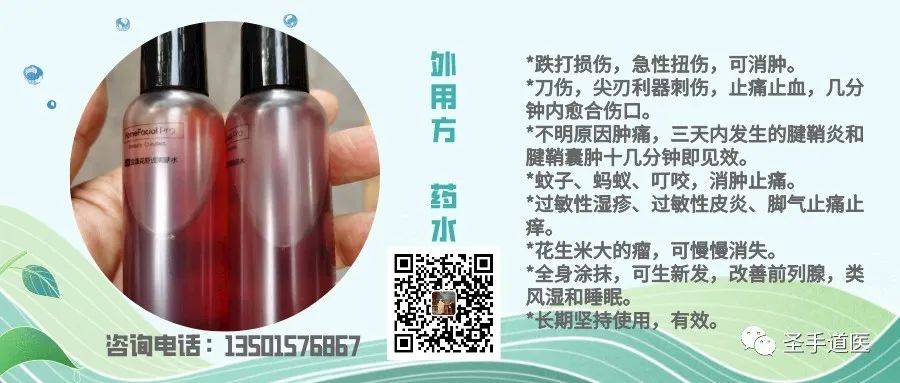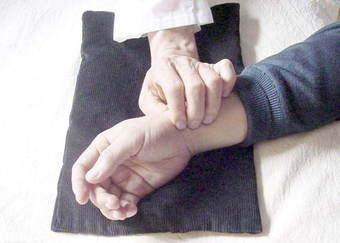

Introduction: Today we continue discussing pulse diagnosis!
5
Long and Short Pulses (with Small Pulses)
The circulation of Yin blood relies entirely on the propulsion of Yang Qi.
Therefore, when the Yin blood within the pulse vessel is abundant, and the Yang Qi outside the vessel is vigorous, the driving force is enhanced, leading to an increased output of blood, resulting in a long pulse;
Conversely, when the Yin blood within the pulse vessel is insufficient, and the Yang Qi outside is in a weakened state, the driving force diminishes, leading to a reduced output of blood, resulting in a short pulse.
Thus, ancient practitioners stated that a long pulse indicates excess, while a short pulse indicates deficiency, which is the essence of this observation.
However, pulse diagnosis must be flexibly applied in conjunction with the patient’s condition and should not be rigidly interpreted.
If the patient’s constitution is still strong and the illness is mild, a long pulse that is also soft indicates a harmonious relationship between form and Qi, suggesting not a pathological pulse, but rather a sign of abundant organ Qi; if the pulse is not long but appears short, it indicates that although the form is solid, the righteous Qi has been damaged, which is a cause for concern even if the illness is mild.
On the contrary, in cases of chronic illness with a weak constitution and severe condition, a short pulse indicates a deficiency of righteous Qi and blood, suggesting a potentially dangerous condition;
If the pulse is not short but appears long with a taut and strong quality, it indicates a deficiency of righteous Qi with an excess of Yang Qi; if the pulse appears long but is soft, it suggests an abundance of original Qi, indicating a potential for recovery despite a severe illness.
From this, it can be seen that a short pulse indicates a deficiency of original Qi, which is an unfavorable sign regardless of whether it is a new or chronic illness.A long pulse indicates an abundance of original Qi, and as long as it is soft, it is not harmful in the presence of various illnesses.
Thus, the Suwen: Pulse Essentials states: “A long pulse indicates Qi is healthy, while a short pulse indicates Qi is ill.” This indicates that a short pulse is indeed a pathological pulse, while a long pulse does not necessarily indicate a pathological condition.
Later practitioners have treated long pulses as a sign of excessive Yang fire; however, a pulse characterized by excessive Yang fire must also exhibit a strong and forceful quality, resembling a solid pulse rather than merely a long pulse.
As for small pulses, their quality is short and small, unlike thin pulses which are merely thin and long; short pulses are short but not thin. This indicates a deficiency of Yin blood and a weakness of Yang Qi. When Yin blood is low, the pulse is less filled and appears thin; when Yang Qi is deficient, the driving force is weakened, leading to a reduced output of blood.
Therefore, the Ling Shu: Evil Qi and Organ Disease states: “A large pulse indicates abundant Qi and less blood, while a small pulse indicates both Qi and blood are deficient”; it also states: “All small pulses indicate a deficiency of both Yin and Yang Qi, and should not be treated with needles but rather supplemented with sweet herbs.” This indicates that small pulses signify a deficiency of both Qi and blood, and should only be treated with tonification.
6
Flooding and Large Pulses
Flooding and large pulses both indicate a vigorous Qi and fiery heat condition, differing only in degree.
The human body is governed by Yin and Yang, which correspond to water and fire, and water and fire correspond to Qi and blood.
If a warm pathogen invades internally, or if an internal pathogen transforms into heat over time, the heat pathogen supports Yang, leading to an excess of Yang and thus an excess of fire, resulting in an overabundance of Qi.
This excess Qi, with insufficient water and Yin, and an excess of Yang heat, causes the Yang Qi to expand outward, enhancing the driving force, resulting in a floating pulse; when the heat pathogen presses inward, the pulse vessel expands due to the heat, forming a large pulse.
If Yang Qi becomes excessively hyperactive, and fire heat obstructs internally, affecting the San Jiao (Triple Burner) and externally the muscles and skin, it is purely the action of fire heat. When fire is excessive, Qi becomes more vigorous, and the force of the pulse becomes stronger.
Previously, blood was guarded by Qi, but now Yang Qi is in action, causing blood to surge uncontrollably, hence the pulse is not only floating but also large, and within the large pulse, it is slippery and rapid, surging like boiling water, which is characteristic of a flooding pulse.
From this, it can be seen that both flooding and large pulses belong to a condition of excessive Qi and fiery heat, which is quite evident. When Yang Qi is excessive, it harms Yin blood; when the fire heat is severe, it injures the water and Yin Qi.
Thus, the Neijing states: “A large pulse indicates the disease is progressing,” “A large pulse indicates abundant Qi and less blood,” and “A flooding pulse is a hook, governing the summer months, indicating excess.” All these phrases refer to both pulses as indicative of excessive Yang heat, and caution against the injury to Yin Qi. Therefore, if a large pulse is seen as deficient, and a flooding pulse is seen as hollow, then in clearing heat, one must also include substances that generate fluids; otherwise, although the evil heat is removed, the true Yin will be depleted, which is not the correct treatment.
As for the statement in the Jinkui Yaolue: Deficiency and Labor that “a man’s large pulse indicates labor,” it refers to emotional injuries, internal consumption of essence and blood, and an excess of Yin deficiency and fire, with an excess of Qi, which is different from the aforementioned large pulse caused by external pathogens. Thus, the treatment principles differ: the former focuses on clearing heat, while the latter emphasizes nourishing Yin, one being deficient and the other being excessive, which is a significant difference.
7
Weak and Soft Pulses (with Scattered Pulses)
Weak and soft pulses, along with micro and thin pulses, have historically been poorly understood by practitioners.
Weak pulses are thin, while soft pulses are fine; when micro and thin pulses are seen in floating conditions, they are classified as weak, and when seen in sinking conditions, they are classified as soft. This highlights the main similarities and differences between these four pulse types.
Since weak pulses indicate a deficiency of Yang Qi, and thin pulses indicate a deficiency of Yin blood, the combination of weak and thin pulses indicates a deficiency of both Qi and blood. Now, both weak and soft pulses exhibit the characteristics of thin and micro pulses, indicating that both pulses signify a deficiency of Qi and blood.
The difference is that a weak pulse appears in a floating condition, indicating that although both Qi and blood are deficient, there is still a trace of Yang Qi floating outward. This indicates that Yin blood is severely depleted, and the residual Yang is without support, hence the pulse is soft and can still be felt in a floating condition.
A soft pulse appears in a sinking condition, indicating a deficiency of both Qi and blood, with a more pronounced deficiency of Qi. When Qi is deficient, the driving force is weakened, leading to a lack of vitality, hence the pulse is soft and can only be felt in a sinking condition. Both weak and soft pulses indicate a deficiency of both Qi and blood, with one being more Yin deficient and the other more Yang deficient.
Generally, individuals have different constitutions, and the causes of illness vary, leading to unpredictable changes. Some may have Qi deficiency without blood deficiency, while others may have blood deficiency without Qi deficiency; some may have a deficiency of both Qi and blood leaning towards Qi deficiency, while others may lean towards blood deficiency; some may have extreme deficiencies of both Qi and blood, with a greater deficiency of Qi, while others may have extreme deficiencies of both Qi and blood with a greater deficiency of blood.
On the surface, it appears to be a deficiency of Qi and blood; however, due to the varying degrees of deficiency, the pulse manifestations also differ. For instance, a weak pulse indicates Qi deficiency, while a soft pulse also indicates Qi deficiency; a thin pulse indicates blood deficiency, while a weak pulse also indicates blood deficiency; the issue is that the weakness of weak and soft pulses is based on the extreme deficiency of both Qi and blood, leaning towards blood deficiency or Qi deficiency.
Thus, the degree of deficiency varies, leading to different pulse reflections, which requires careful analysis of the principles of Yin and Yang, water and fire, Qi and blood deficiency and excess in pulse diagnosis.
It is essential to understand this principle to classify pulse types, distinguish between deficiency and excess, weigh the severity, and achieve effective flexible application.
As for scattered pulses, they are characterized by a floating and scattered quality, appearing large, but when pressed, they are absent, unclear in their arrival and departure, and lack a solid foundation. They are neither as thin as micro pulses nor as soft as weak pulses. This indicates a complete depletion of Yin blood and a dispersion of Yang Qi. Such pulses indicate various diseases, and the treatment principle is not to treat.
This article is excerpted from Zhutang Yijing, authored by Qian Yuanming, organized by Cai Yuqin and Li Xuanjin, published by Central China Normal University Press, December 1992. Please cite the source when reproducing.

More Exciting Content
The ancient formula “San Liang Ban” is effective for quick recovery from lumbar muscle strain!
Wondering about longevity? Your face knows! The Huangdi Neijing teaches you how to read facial features!
Women with liver Qi stagnation exhibit 5 most obvious symptoms! The sooner you know, the better!
Over 40 small remedies for common ailments, covering almost all daily illnesses (save this)!
How to remember nearly 400 acupuncture points? Discussing their past and present (save this)!
Daoist health preservation tips, detailed explanations of the 24 solar terms for health, with tips for year-round health!
Why is it said that fire rises while cold sinks, and the legs are a major site for cold? How to dispel cold? All in one step!
These 100 folk remedies are worth saving for the whole family! The 91st is super useful! (Recommended to save)

